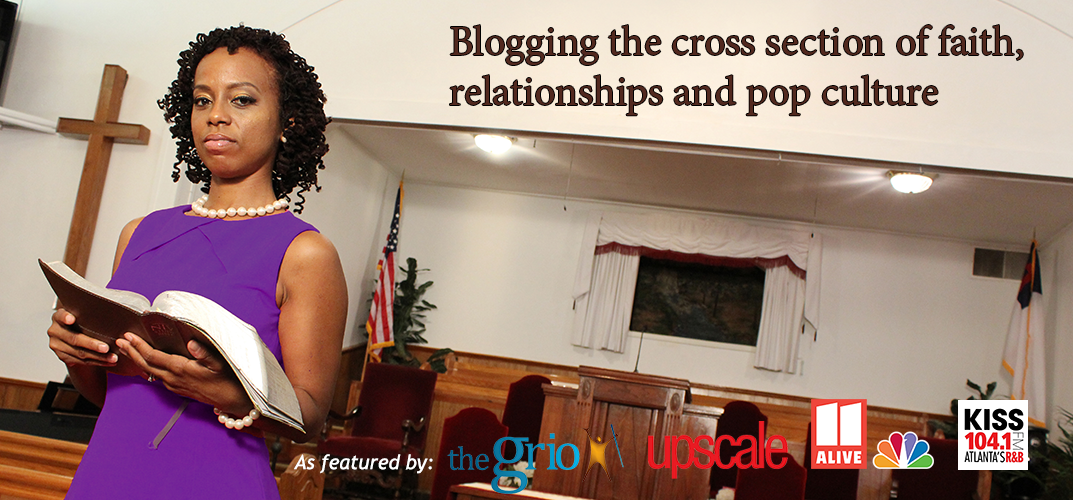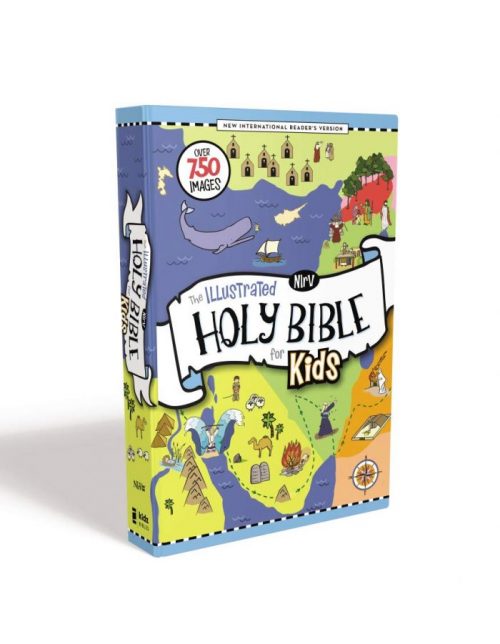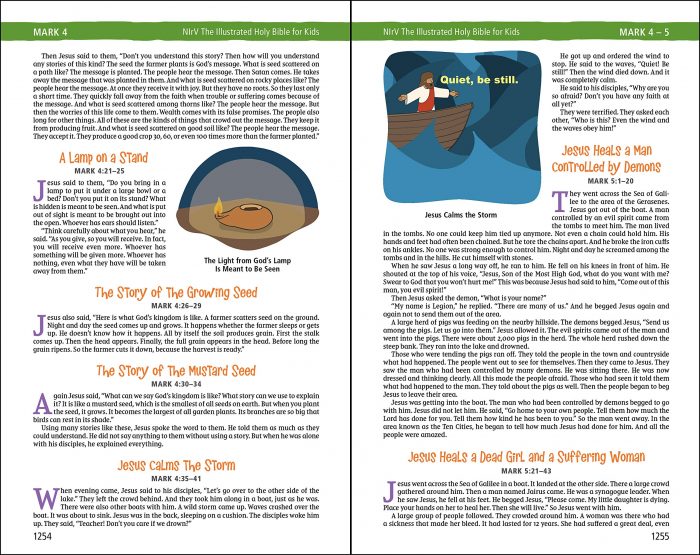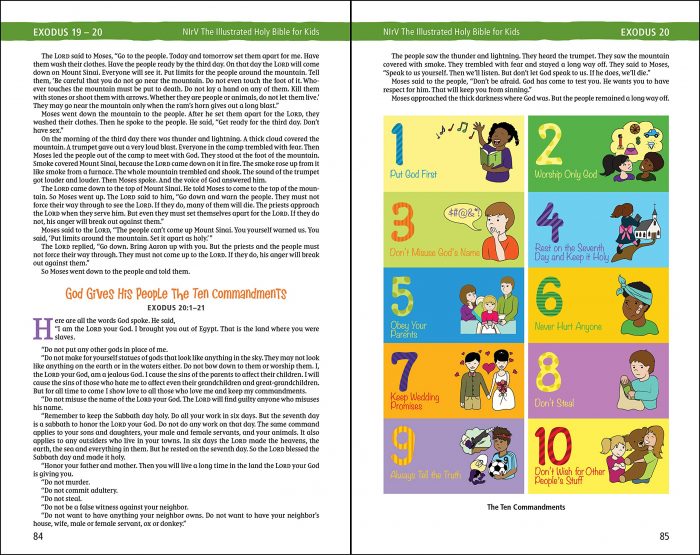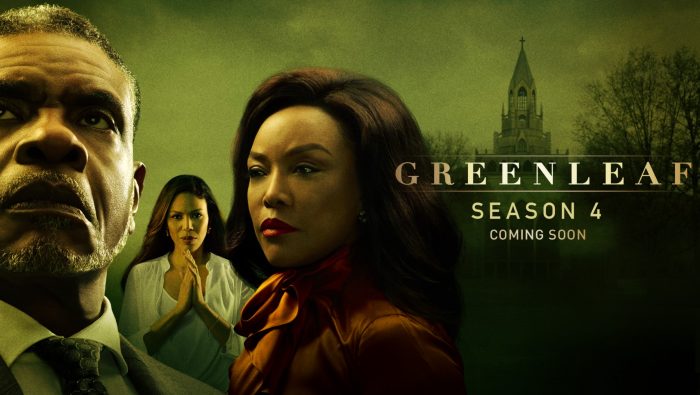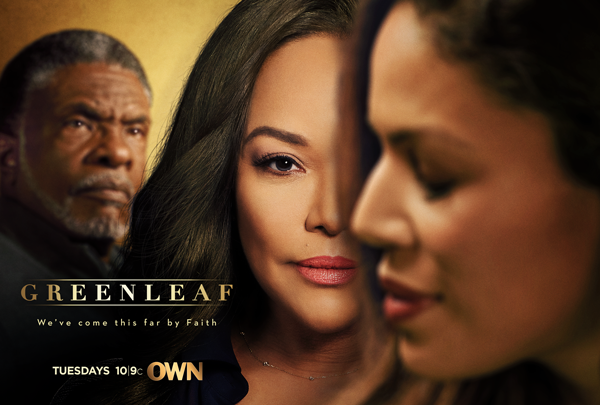
Hello World,
The wait for the return of OWN’s “Greenleaf” is OVER!!! So I won’t make you wait to get this Greenleaf Recap Season 4 Episode 1: Original Sin …
O.G. Original Gangster
Like the original gangster that he is, Bob Whitmore is front and center on the stage between his henchman Phil DeMars and Grace as Calvary’s praise and worship (led by a woman who is not Charity) ushers in Sunday morning service. Once the praise and worship is complete, Bob strides up to the podium and says, “Good Morning Calvary.” He delivers his cheery greeting with all of the sincerity of a snake. “Wasn’t that a wonderful performance? So much energy.” He then proceeds to compliment the congregation on all of the “beautiful hats” he sees in the church. First of all, praise and worship is not a performance. It’s praise to and worship of the Lord. And secondly, he sounds like an original neophyte instead of an O.G. making a comment about church hats. A hat in a church is almost as common as a Bible in a church.
Whitmore goes on with his speech over a podium where the Harmony & Hope moniker is now clearly displayed. “Welcome to the family,” he says before introducing Phil, who is the southeast conference leader of the church stealing conglomerate. He also said that he was so glad that Deaconness Connie Sykes approached him about taking over Calvary as he had been eyeing the church from afar. He recalls that he said, “I’d like to get in on that.”
Looking on from the audience, Bishop tells Lady Mae that what Bob really meant to say is that he would like to “get in on that money.” It’s so disconcerting to see all of the Greenleafs except Grace in the audience rather than on stage as they were before. And even Grace is not getting her respect as Bob whispers to Grace to keep her sermon short after he introduces her as the interim pastor. Once the service is over, the Greenleafs critique the service as well as the overall feel of the church now that they are simply parishioners rather in the pulpit. Bishop says he feels like a “ghost moving unseen in a house that I built” while Lady Mae says Grace’s sermon was “concise.” But Grace reminds her parents that they must remain cool if they are to reclaim their church.
Just one note. #Greenleaf pic.twitter.com/u52K4ngSro
— Greenleaf OWN (@GreenleafOWN) September 4, 2019
Lady Mae agrees but then she approaches Bob anyway. She tells Bob that her daughter’s sermon was more like a “minister’s minute.” When Bob says something to the effect that time is money, she points that “money shouldn’t be a metric when measuring things of the spirit.” Bob points out that a shorter service would pave the way for a third service and that congregants want to know what to expect when coming to a Harmony & Hope church service similarly to a McDonald’s. (I guess this episode was shot before the Chick-fil-A/Popeye’s war teehee.) And then Lady Mae delivers one of her zingers. “There are two things that human beings do together that are best done when done slowly and preaching is one of them.” LOL. I will let you guess the other thing…
Grace meets with Phil to discuss hiring Jacob and Charity as associate pastors. But Phil shuts her down by reminding her about what happened at Triumph although Basie Skanks framed Jacob and what happened with Charity being nearly accused of kidnapping her child. She tells him that they don’t have to be officially associate pastors. They can even be called assistants, but Phil says, “It’s never going to happen.”
We’ll see about that. #Greenleaf pic.twitter.com/pw4KeBeiwn
— Greenleaf OWN (@GreenleafOWN) September 4, 2019
You’re An Original…
Although Bob is at Bishop’s desk when Bishop charges into his vacated office, it’s clear that there will never be another like Bishop. In his walk and talk and overall presence, he’s got the ingredients of a beloved shepherd. Bob is just fooling himself if he thinks he is going to erase Bishop’s legacy and steal the flock for himself. Bishop tells Bob that he knows what the man is up to and his reputation has preceded him. Apparently, a pastor friend of his, Mike Evans, who was the shepherd over Jericho Faith Fellowship, was pushed out of his own church due to Harmony & Hope Ministries. The organization hired a private investigator to drum up some dirt on him and discovered that Pastor Mike got addicted to painkillers after injuring himself while helping Katrina survivors. Bob and his gang shared that intel with Jericho’s board and Pastor Mike was pushed out. Harmony & Hope brought down the wall around Jericho and took it over as a result.
Bishop says, “I don’t know what you’re doing here, but I’m going to find out.” He then tells Bob that his “magic carpet of a denomination is going to dissolve like smoke” when he’s through with him. Yaaas, Bishop! Tell him! “Your days are numbered,” are Bishop’s final benediction. Bob says he hopes the Lord releases him from the “spirit of resentment.” And then he really sticks it to him by telling Bishop that he met Bishop’s ex-wife. “She’s a spitfire! How did you let her get away?” I guess that was Bob’s way of saying that if he let his beloved wife get away and then it’s no wonder that his church is being stolen from him. That’s alright, Bishop. You made some mistakes, but you can make up for those mistakes. That’s what repentance is all about.
Speaking of mistakes, since it was revealed last season that Lady Mae’s indiscretion resulted in the birth of Grace, Aaron is as much her brother as Jacob is. And so he calls his big sister and for the first time, she refers to him as her “little brother.” Was I the only one who was a little “weirded out” by their conversation? I know they are related, but I still only see Jacob as her only brother.
Original Prankster…
Zora Greenleaf, our favorite juvenile delinquent, has moved along with her parents back to the Greenleaf home on the estate. But her little brother, who is finally growing up a little, is annoying her as he is always passing gas. She tells her parents that she is a “grown-a$$ woman” and she should be allowed to move into Noah’s old cabin for the sake of her sense of smell and overall sanity. This woman-child is beyond bold. I mean the girl caused her parents to go through hell last season and now she wants to rewarded with her own place rent-free?! I think she should be forced to sleep with her stinky brother.
And speaking of things that stink…When Jacob gets a voicemail from a Dora Saunders, Kerissa is paranoid that Dora is really Tasha Skanks. “How come I’ve never met her?” Kerissa asks Jacob. She wonders aloud if Basie, Tasha and Rochelle, three pranksters for real, are still conspiring to further damage Jacob and Kerissa. She says to Jacob, “Don’t call back.”
Meanwhile back at Calvary, the two new pranksters of Season 4, Bob and Phil, discuss their plan to completely conquer Calvary. Bob is concerned that although the Greenleafs seem to be reasonably compliant, they are likely concocting a scheme as they speak. And Bob is right. Back at the estate, at the family dining room table, Grace reveals to her family that her request to get Jacob and Charity put on as associate pastors has resulted in “dookie” in Charity’s words. (I think she’s still dranking…and she’s not the only one as you will find out later…)
Charity is not having it. #Greenleaf pic.twitter.com/iZtX3rjKbl
— Greenleaf OWN (@GreenleafOWN) September 4, 2019
And Kerissa goes on to say that the Greenleafs have been on a “swift slide down” ever since the prodigal daughter Grace returned. She tells her in-laws that they can “side eye me all you want.” And furthermore, she tells that the family that she is not at all happy that she is living under the Greenleaf roof again before she stomps out of the room. Bishop says to Jacob, “You need to handle your business and keep her out of the wine.”
And then top all of that off, Charity screeches that she should be an associate pastor before she also stomps out of the room like the petulant last child that she is. Lady Mae says, “The sins and stupidity that this poor table has seen. I’m surprised it doesn’t just crash to the floor.” You’ve got to love Lady Mae and her language! Once the room has cleared, Lady Mae goes to Grace. She tells her daughter that she did nothing wrong. Wow! I hope Grace burns her mother’s words in her memory because she may never hear those words slip from mother’s lips ever again.
You did all you could, Grace. #Greenleaf pic.twitter.com/Z7OMo6jshE
— Greenleaf OWN (@GreenleafOWN) September 4, 2019
Grace wants to tell Jacob and Charity that she is really their half-sister, but Lady Mae says, “We will tell them once we have won our church back.” I agree. Right now, their efforts need to be laser-focused and if they find out that Grace is their mother’s love child, they family would be splintered, in more ways than one, in their efforts. She then tells her daughter that she should not ask that her brother and sister be hired. She should tell them they will. And she kisses Grace on the cheek!!!
Per usual, Jacob defies his wife’s instruction and calls Dora Saunders back. Apparently, her son plays NBA basketball for the Memphis Red Devils and needs a spiritual adviser and or life coach. The team’s name alone should get Jacob running not walking in the opposite direction, but the man is without a job so the devil’s offer beckons him.
Later on that evening, Bishop, with his sly self, sees Lady Mae slip off her clothes to reveal lingerie. It’s been all last season since those two became one so to speak and Bishop wants to move back into their bedroom. “When do you see me moving back in here?” Lady Mae replies, “When we’re in love.” Bishop is surprised that Lady Mae didn’t just fall back in love with him and asks her if flowers and a ring will do the trick. Lady Mae levels with him. “You are courting a woman who has had everything. You will have to sweep me off my feet…in ways that I can’t even imagine.” Wow. Although the Greenleafs have to win their church back, Bishop has to win Lady Mae back too.
Isn’t that when people do that sort of thing? #Greenleaf pic.twitter.com/Zceit1grxo
— Greenleaf OWN (@GreenleafOWN) September 4, 2019
And even later that evening, in the middle of the night actually, Grace gets a call from some inmate…Is this a prank call?
Get Original…
You must know that Lady Mae is an original. When you think you are getting something that you want from her, you realize that she will always get what she wants first and foremost. She allows Zora to live in Noah’s abandoned cabin. (Remember Noah from Season 1? He was Grace’s original love.) But in exchange for her more free living arrangements, she will resume meeting with her grandmother for their early morning Bible study sessions. Speaking of Noah, he calls Grace and asks her to call him back per her voicemail…Hmmm…
Charity decides to come up with an original plan to regain Calvary. She, by her lonesome, meets with Phil. She tells him she is better than Grace. Phil picks up on Charity’s frustration and asks her to be his “eyes and ears” among the Greenleafs in exchange for a position.
Speaking of a position, Jacob meets with a member of the Memphis Red Devils management team. He is told he is more likely to get the job as a spiritual adviser and or life coach if he is already on staff at a church, especially after what happened at Triumph. Unlike Charity, he still believes that his sister is working on his behalf to secure a position at Calvary. And Grace is. She tells Bob that she is willing to walk away from Calvary if he doesn’t hire her brother and sister. Bob tells her that he has been following her since her days as a television reporter in Arizona. Uh-oh. You know this means that Bob has dirt on her just like he did on Bishop’s friend Pastor Mike. He tells Grace that “putting family first is a mistake” although he does agree to bring on Jacob as an associate pastor.
Now that Grace has secured Jacob’s position at Calvary, his position as the spiritual adviser and or life coach for Dante Saunders of the Memphis Red Devils is set and Zora tells her cousin that she wants to be Daunte’s love coach. Sophia points out that Zora is always falling for the bad boy. Apparently, this dude drove over a Confederate statue or something while drunk.
But Charity is not satisfied that at least her brother was hired as an associate pastor. When she hears the news, she calls Phil and tells him, “I’m in.”
Grace has more to worry about than her spying little sister though. Noah calls her again and finally reaches her. He says, “Why haven’t you called me back? An inmate from Arizona called me and he says he’s our son!” Well, close my Bible and call Grace a sinner. Lady Mae isn’t the only one with a love child. What we thought was an original sin in the Greenleaf family is actually a legacy sin. Like mother, like daughter…Wow…More will be revealed I’m sure.
In the voice of the incomparable Bishop T.D. Jakes, “Get ready, Get ready, Get ready.” In fact, Saints, cash app me your tithe because I’m about to put in work this Season 4 I can already tell…LOL…
Thank you sooo much for reading my Greenleaf Recap Season 4 Episode 1: Original Sin and my other recaps so far. If you would like to keep up with OWN’s “Greenleaf,” and my recaps, please click on this link to subscribe to my blog 
Any thoughts?
